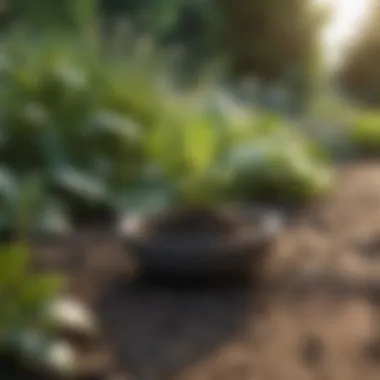Understanding and Managing Early Blight in Gardens


Intro
Early blight is a fungal disease that often poses significant challenges for gardeners, particularly those growing tomatoes and potatoes. Recognizing the threat of early blight is essential for maintaining healthy plants and ensuring fruitful harvests. This guide aims to provide homeowners and gardening enthusiasts with an in-depth understanding of early blight, its causes, and its symptoms. Moreover, we will discuss effective treatments and prevention strategies that can help empower gardeners in their efforts to combat this pervasive disease.
The relevance of understanding early blight cannot be understated. For many, the joy of gardening is deeply tied to the satisfaction of nurturing plants and enjoying fresh produce. However, early blight can quickly diminish that satisfaction, leading to disappointment and loss. By equipping oneself with knowledge about early blight, gardeners can take proactive steps to protect their plants and cultivate a thriving garden.
In the sections that follow, we will examine crucial aspects of early blight, from its origins and symptomatology to practical management strategies. With this comprehensive approach, gardeners will be better positioned to face this challenge head-on, ensuring the vitality of their gardens.
Prolusion to Early Blight
Early blight stands out as a significant fungal disease impacting gardens. Its repercussions can be devastating for tomatoes and potatoes, which are popular plants among gardeners. Understanding early blight is crucial for several reasons. First, early identification of the disease allows gardeners to implement timely management practices. Secondly, awareness of the disease's lifecycle can help in preventing outbreaks. This knowledge empowers gardeners to cultivate healthier plants and achieve better yields.
Definition and Overview
Early blight is primarily caused by the fungus Alternaria solani. This disease manifests as dark, concentric spots on leaves, leading to premature leaf drop. The conditions under which early blight thrives are often moist and warm, making gardens particularly vulnerable during specific seasons. It is essential for gardeners to be familiar with the symptoms to differentiate early blight from other common plant diseases.
Significance in Gardening
The impact of early blight extends beyond mere aesthetic concerns. The economic implications for home gardeners are evident when yield loss occurs. This fungal infection can lead to reduced productivity, which ultimately affects food supply for families who depend on their gardens.
Additionally, early blight can stress the plants, making them more susceptible to other diseases. Understanding this significance motivates gardeners to adopt proactive measures. By managing early blight effectively, one can ensure that plants remain resilient and productive, contributing to a flourishing garden environment.
By learning the key characteristics and importance of early blight, gardeners can better prepare for and address potential outbreaks.
Biology of the Pathogen
Understanding the biology of the pathogen responsible for early blight is essential for effective management. This section provides insights into the characteristics of the fungus and its life cycle, which are crucial for identifying its impact on plants and developing appropriate treatment strategies.
Fungal Characteristics
The primary agent of early blight is the fungus Alternaria solani. This pathogen is known for its resilience and adaptability. One of the distinguishing features of Alternaria solani is its dark, olive-green to black conidia, which are asexual spores that facilitate its spread. The size and shape of these spores can vary, but they often exhibit a characteristic club-like appearance. This adaptability contributes to its capacity for rapid growth under favorable conditions.
Fungal hyphae can penetrate leaf tissue, leading to the formation of dark lesions. These lesions grow larger and often result in tissue death, severely affecting photosynthesis, which is critical for plant health. A single infection can lead to extensive damage if not managed properly. The capacity of the fungus to survive on infected plant debris and in the soil contributes to its persistence in garden ecosystems. It can remain viable for years, increasing the complexity of management efforts.
Life Cycle of the Pathogen
The life cycle of Alternaria solani is typically divided into several stages, each contributing to its spread and impact on plants. The cycle begins with the germination of spores, which can be triggered by moisture and warm temperatures, conditions that often prevail in the growing season.
- Infection Initiation: Spores germinate on leaf surfaces, facilitated by wetness. They invade tissue through the natural openings of plants, like stomata, or through wounds.
- Symptom Development: Following infection, the fungus grows within the plant tissue, leading to the formation of symptoms such as dark lesions on leaves. These lesions can greatly inhibit the plant’s ability to photosynthesize.
- Spores Production: As the disease progresses, the fungus produces new spores that can be dispersed by wind, rain, or contaminated tools. This dispersal is a significant factor in how quickly early blight can spread within a garden.
- Survival and Overwintering: The pathogen can survive unfavorable conditions by remaining in plant debris or in soil. This ability to persist is a major concern for gardeners, as it means the pathogen can re-emerge in the next growing season regardless of whether specific host plants are present.
By understanding the biology of Alternaria solani, gardeners can implement more effective management strategies. Awareness of its characteristics and life cycle allows for proactive measures during key stages of its development, ultimately leading to healthier gardens and more sustainable plant growth.
Identifying Early Blight
Identifying early blight is crucial for effective management of this common fungal disease that affects various plants, most notably tomatoes and potatoes. Early identification enables gardeners to take timely action, which can significantly reduce the impact on crop yield and plant health. Knowing what to look for ensures that intervention measures can be implemented before the disease spreads extensively. Understanding the signs and symptoms of early blight is the first step towards protecting your garden from this adversary.
Common Symptoms


The symptoms of early blight can initially be subtle but become increasingly apparent as the infection progresses. Key symptoms include:
- Leaf Spots: The most identifiable symptom is the appearance of circular, dark brown spots on the leaves. These spots often have a yellow halo, indicating tissue damage.
- Wilting and Browning: Infected leaves may start to wilt and turn brown, leading to premature leaf drop. This can weaken the plant significantly.
- Stem Lesions: Early blight can also affect stems, producing dark lesions that may lead to stem decay.
- Overall Stunting: Plants may exhibit stunted growth due to nutrient loss and physical damage caused by the disease.
These symptoms typically manifest during warm and humid conditions, which favor the growth of the pathogen. Monitoring your plants regularly for these signs is essential to enable timely action.
Differentiating from Other Diseases
Correctly identifying early blight is important, as it can resemble several other plant diseases. It is essential to distinguish it from:
- Late Blight: While late blight appears in a similar manner, it tends to occur in cooler, wetter conditions and primarily affects tomatoes and potatoes. The lesions can spread rapidly and are often surrounded by a more water-soaked appearance.
- Septoria Leaf Spot: Commonly seen in tomatoes, this disease produces small, circular spots that may also have a yellow halo. However, symptoms are usually confined to lower leaves and arise late in the season.
- Bacterial Wilt: This condition causes wilting and yellowing of leaves as well, but it may also include a distinct watery ooze from cut stems.
When observing symptoms, consider not just the appearance of the lesions but also the environmental conditions and other associated symptoms. Accurate diagnosis is fundamental to choosing an appropriate treatment strategy.
Essential Insight: Identifying early blight promptly allows you to implement prevention and treatment measures, ultimately safeguarding your garden's health.
Factors Contributing to Early Blight
Understanding the factors that contribute to early blight is crucial for effective management and prevention. This part will delve into how specific environmental conditions and plant stressors act as catalysts for the disease. Recognizing these elements can significantly improve a gardener's ability to protect their crops.
Environmental Conditions
The environment plays a pivotal role in the development of early blight. Certain climatic factors can create an ideal setting for the fungal pathogen, Alternaria solani, to flourish. Here are some key environmental conditions to consider:
- Humidity Levels: High humidity encourages the growth and spread of the fungus. When moisture levels in the air exceed 85%, the likelihood of infection increases. Gardens that are shaded or poorly ventilated are particularly vulnerable.
- Temperature: The optimal temperature range for the development of early blight is between 60°F and 80°F. In this range, the pathogen's life cycle accelerates. During hot spells where temperatures rise above 85°F, the disease may become less prevalent, but the stress on plants may make them more susceptible upon cooling.
- Rainfall: Excessive rainfall can lead to waterlogged soil and wet foliage, both of which create conditions ripe for infection. Prolonged wet periods allow fungal spores to germinate and spread easily.
Understanding these conditions enables gardeners to take preventive measures. For instance, ensuring proper air circulation or avoiding overhead watering during high humidity can mitigate risks.
Plant Stressors
Plant stressors can exacerbate the effects of environmental conditions, making plants more vulnerable to early blight. Here are some common stressors:
- Nutrient Deficiencies: Insufficient nutrients can weaken plants. A lack of nitrogen, potassium, or phosphorus may lead to stunted growth or a decline in overall health, increasing susceptibility to diseases like early blight.
- Water Stress: Either drought or excessive moisture can stress plants. Drought conditions can cause wilting and result in a less robust plant structure. Conversely, too much water can suffocate roots and reduce vigor.
- Poor Soil Health: Soil that lacks organic matter or has imbalanced pH levels can impact plant growth negatively. Healthy soil fosters strong root systems, which support plant resilience against diseases.
- Crowded Planting: When plants are too close together, airflow is restricted. This can lead to prolonged leaf wetness, conditions ideal for Alternaria solani to thrive.
By recognizing and addressing these stressors, gardeners can enhance the health of their plants and mitigate the risk of early blight.
"Prevention is often better than treatment, especially in dealing with plant diseases such as early blight.
In summary, both environmental conditions and plant stressors play a significant role in the emergence of early blight. By cultivating awareness around these factors, gardeners can implement better practices to protect their crops and maintain a healthy garden.
Preventative Measures
Preventative measures play a crucial role in managing early blight in gardens. Focusing on prevention can save time and resources in the long run. It helps maintain healthier plants, reduces the severity of infection, and minimizes the need for reactive treatments. Understanding
Treatment Options for Early Blight
Treatment options for early blight are essential in managing this fungal disease effectively. Gardeners facing an early blight outbreak must choose appropriate methods to help restore their plants' health. Recognizing that different scenarios require different solutions, both preventative and responsive tactics come into play. Not only do these treatment methods help in alleviating immediate symptoms, but they also contribute to long-term plant health and yield stability. A comprehensive understanding of the available treatments—spanning cultural practices, chemical treatments, and organic solutions—enables gardeners to tailor their approaches effectively.
Cultural Practices


Cultural practices are the first line of defense against early blight. These strategies focus on modifying the growing environment and plant care to reduce disease likelihood. Here are key elements of cultural practices:
- Proper Watering Techniques: Overhead watering can lead to increased humidity on leaves, fostering fungal growth. Drip irrigation is recommended to keep leaves dry.
- Adequate Space: Avoid overcrowding plants. Good air circulation helps to reduce humidity around foliage, which can deter the onset of disease.
- Regular Pruning: Removing dead or diseased leaves promptly is vital. This not only improves air circulation but also prevents further spread of spores.
- Mulching: Applying organic mulch can regulate soil temperature and moisture, limiting conditions for fungi to thrive.
Engaging in these practices not only mitigates immediate invasion but also enhances overall plant vigor, preparing them better for any potential blight encountered in future growing cycles.
Chemical Treatments
When cultural practices alone are insufficient, chemical treatments can be employed judiciously. These products tend to be fungicides aimed at controlling specific pathogens. Important considerations include:
- Selectivity: Choose fungicides that are specifically labeled for early blight, ensuring targeted action without harming beneficial organisms.
- Timing of Application: It’s crucial to apply fungicides preventively or at the first sign of outbreak. Follow label instructions regarding frequency and dosage.
- Resistance Management: Rotate fungicide classes to reduce the likelihood of pathogen resistance. This keeps treatments effective over time.
Chemical treatments can be an effective option, but their efficacy hinges on their application timing and adherence to recommended usage guidelines.
Organic Solutions
For gardeners preferring ecologically friendly approaches, organic solutions offer viable alternatives to conventional chemicals. Many organic treatments have shown effectiveness against early blight. Here are some options:
- Neem Oil: Known for its antifungal properties, neem oil is effective when applied early in the disease cycle.
- Baking Soda: A mixture of baking soda and water can deter fungal growth. Ensure to apply this solution early in the morning or late in the evening to avoid leaf burn.
- Milk Spray: Milk has been shown to improve plant defenses against fungal diseases. Mixing one part milk with two parts water and spraying on foliage can be beneficial.
Using organic solutions not only addresses the current issue but also aligns with an overall commitment to sustainable gardening practices. It fosters a healthier ecosystem within the garden.
Implementing Integrated Pest Management (IPM)
Integrated Pest Management (IPM) is a holistic approach to managing pests and diseases, particularly early blight in gardens. This strategy relies on a combination of practices, considering ecological factors and pest behaviors. Applying IPM principles helps homeowners maintain healthier gardens by minimizing chemical usage while maximizing plant vitality. Understanding IPM principles is essential for effective management of early blight.
Understanding IPM Principles
IPM is not just about controlling pests or diseases when they arise; it is about creating conditions that prevent these issues from developing in the first place. Key elements of IPM include:
- Monitoring: Regularly check plants for symptoms of early blight and other issues.
- Identification: Confirm that the problem is indeed early blight by examining symptoms closely.
- Prevention: Implement cultural practices that deter the disease. This can include proper watering techniques, crop rotation, and selecting disease-resistant plant varieties.
- Control: When intervention is necessary, employ the least harmful options first. This may include organic solutions or cultural practices before resorting to chemical treatments.
By adopting these principles, gardeners can reduce reliance on chemical controls and foster a more sustainable gardening environment. This approach not only saves costs in the long run but also contributes to an overall healthier ecosystem.
Role of Monitoring and Assessment
Monitoring and assessment are central to the effective implementation of IPM. Gardeners need to be proactive in observing their plants. This involves:
- Regular Inspections: Checking for early signs of early blight, such as yellowing leaves or dark spots can help in taking timely action.
- Data Collection: Keeping records of pest or fungal pressures can help in understanding trends and making informed decisions.
- Thresholds for Action: Knowing when to act is crucial. Not every symptom necessitates intervention. Setting thresholds allows gardeners to balance plant health and intervention efforts.
"The first step in any IPM program is accurate monitoring of pest and disease levels."
Effective monitoring enables gardeners to apply the right treatment at the right time, optimizing results and minimizing impact. This combination of proactive monitoring and strategic intervention is integral to managing early blight efficiently.
Adopting IPM strategies enhances the sustainability of gardening practices, supporting healthier produce and a robust garden ecosystem. It empowers gardeners to take control of their growing environments while minimizing their ecological footprint.
Long-term Management Strategies
Long-term management strategies are crucial for gardeners aiming to combat early blight effectively. By implementing these strategies, gardeners can not only mitigate the disease's severity but also promote a healthier ecosystem in their gardens. This multifaceted approach not only addresses current issues but also reduces the risk of future outbreaks, creating a sustainable environment for plant growth.


Maintaining Soil Health
Soil health is fundamental to sustainable gardening practices. Healthy soil promotes plant vigor and resilience against diseases like early blight. A prime focus is on the soil microbiome, which supports nutrient cycling and plant growth. To maintain soil health, consider the following practices:
- Regular Testing: Conduct routine soil tests to monitor pH, nutrient levels, and microbial activity. Understanding these components allows for precise amendments.
- Organic Matter Addition: Incorporate compost, manure, or other organic materials. This boosts the nutrient content and improves soil structure.
- Cover Cropping: Grow cover crops during off-seasons. They enhance soil fertility and structure while preventing erosion.
- Crop Residue Management: Properly manage plant residues after harvest. Avoid incorporating diseased plant matter back into the soil to prevent pathogen reintroduction.
By focusing on soil health, gardeners set a robust foundation to support their plants against early blight and other diseases.
Seasonal Care Practices
Implementing seasonal care practices is key for adapting to the changing conditions that influence the health of plants and soil. Planning throughout the year ensures that preventive measures are in place to minimize the impact of early blight. Key practices include:
- Spring Preparation: Before planting, ensure that the soil is well-aerated and enriched with organic matter. This prepares the garden bed for vigorous plant growth.
- Regular Monitoring: During the growing season, consistently check for symptoms of early blight and other diseases. Early detection is key for effective management.
- Fall Cleanup: After the growing season ends, remove plant debris from the garden. Diseases can overwinter on decaying matter, so proper disposal is crucial.
- Seasonal Planting Schedule: Time your planting based on local climate conditions. This helps to avoid peak periods for fungal outbreaks, thus reducing the potential for disease.
Regularly practicing these seasonal care strategies can considerably impact overall plant health, making them more resistant to early blight and promoting a thriving garden throughout the growing season.
Case Studies
Case studies are a vital component of the examination of early blight's management strategies. They provide real-world examples of both effective and ineffective practices surrounding the treatment of this common fungal disease. By analyzing various case studies, gardeners can better understand the challenges associated with early blight. They can also observe the outcomes of different approaches, helping them refine their own strategies for prevention and treatment.
The benefits of discussing case studies are multi-faceted. Firstly, they create a practical context for theoretical knowledge, allowing garden enthusiasts to see the application of information in a tangible manner. This can enhance understanding and retention of concepts such as resistant varieties and cultural practices. Secondly, case studies demonstrate the potential for success through trial and experimentation, motivating readers to adopt innovative approaches to combat early blight.
Moreover, careful analysis of both successes and failures equips gardeners with crucial insights into which methods yield positive results and which do not. These insights facilitate informed decision-making and adaptation to specific circumstances, ensuring the most suitable methods are implemented in a given garden environment.
Successful Management Examples
One effective case study involved a community garden that faced severe early blight in its tomato crop. The gardeners adjusted their practices by incorporating several strategies, which included rotating crops annually, selecting resistant tomato varieties, and implementing proper watering techniques. Within two growing seasons, they were able to cut down early blight incidence heavily.
Another example comes from a farmer who used an integrated pest management (IPM) approach. The farmer combined cultural practices, such as regular pruning and ensuring adequate airflow between plants, with timely applications of organic fungicides. This holistic method not only reduced the fungal disease's impact but also resulted in a healthier overall growing environment, leading to increased yields.
These cases showcase the effectiveness of employing multiple strategies in managing early blight. When assessing these approaches, it becomes clear that informed and proactive management can lead to significant improvements in plant health and crop quality.
Lessons Learned from Failures
Failing to manage early blight can provide essential learning opportunities for any gardener. For instance, a well-documented case involved a home gardener who chose to plant susceptible varieties without implementing any preventative measures. The result was a complete crop loss after a few weeks of warm, wet weather. This highlighted the importance of not just choosing resistant crops, but also supporting them with proper care practices.
Another failure stemmed from a gardener who ignored the importance of crop rotation. Planting potatoes in the same spot for multiple consecutive years led to a rapid increase in the pathogen load in the soil. The lessons learned from this misstep emphasize the necessity of adopting a rotating schedule for different plants to manage soil health effectively and reduce disease pressure.
In reviewing these failures, it becomes apparent that overlooking fundamental practices can be detrimental. For gardeners, such experiences underline the need to comprise their efforts with resilience, learning, and adaptation to existing conditions. Through failure, one can gain deeper insights into the significance of diligent management in preventing early blight.
End
Understanding early blight is critical for any gardener. This fungal disease can lead to significant losses in crop yields if not managed properly. By grasping the core aspects of early blight, gardeners can implement effective strategies to combat its spread and impact.
Summary of Key Points
- Definition and Impact: Early blight primarily affects tomatoes and potatoes. It's a fungal condition resulting in leaf spotting and eventual decay.
- Preventative Measures: Identifying resistant plant varieties, practicing optimal planting techniques, and adhering to crop rotation are essential in preventing outbreaks.
- Treatment Options: Options range from cultural practices to chemical and organic solutions. Each has its merits depending on the severity of the infestation and personal gardening philosophy.
- Integrated Pest Management (IPM): This approach focuses on understanding pest behaviors and ecology to make informed decisions.
- Long-term Strategies: Maintaining soil health and implementing seasonal care practices enhance plant resilience to diseases like early blight.
Future Considerations in Gardening Practices
As the gardening landscape evolves, so too should the strategies employed to manage early blight. Considerations for the future may include:
- Research and Development: Ongoing studies into genetics of plants resistant to early blight will offer hopes to modify existing varieties.
- Sustainability Practices: Incorporating sustainable gardening techniques will be necessary for long-term success. This includes organic methods and minimal chemical use.
- Education and Awareness: Sharing knowledge and experiences through platforms like Reddit and gardening forums can help others understand early blight better.
- Adapting to Climate Change: Increasing awareness and adaptability to changing weather patterns are essential. These changes influence disease prevalence, necessitating modified management techniques.
Awareness and adaptability are key to successful gardening. Understanding and managing early blight is not just about immediate solutions; it's about preparing for the future.







